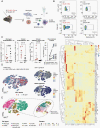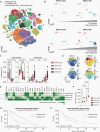Dysfunctional dendritic cells limit antigen-specific T cell response in glioma
- PMID: 35609569
- PMCID: PMC9925697
- DOI: 10.1093/neuonc/noac138
Dysfunctional dendritic cells limit antigen-specific T cell response in glioma
Abstract
Background: Dendritic cells (DC), the most potent professional antigen presenting cells capable of effective cross-presentation, have been demonstrated to license T helper cells to induce antitumor immunity in solid tumors. Specific DC subtypes are recruited to the injured brain by microglial chemokines, locally adapting to distinct transcriptional profiles. In isocitrate dehydrogenase (IDH) type 1 mutant gliomas, monocyte-derived macrophages have recently been shown to display an attenuated intratumoral antigen presentation capacity as consequence of the local accumulation of the oncometabolite R-2-hydroxyglutarate. The functionality and the contribution of DC to the IDH-mutant tumor microenvironment (TME) remains unclear.
Methods: Frequencies and intratumoral phenotypes of human DC in IDH-wildtype (IDHwt) and -mutant high-grade gliomas are comparatively assessed by transcriptomic and proteomic profiling. DC functionality is investigated in experimental murine glioblastomas expressing the model antigen ovalbumin. Single-cell sequencing-based pseudotime analyses and spectral flow cytometric analyses are used to profile DC states longitudinally.
Results: DC are present in primary and recurrent high-grade gliomas and interact with other immune cell types within the TME. In murine glioblastomas, we find an IDH-status-associated major histocompatibility class I-restricted cross-presentation of tumor antigens by DC specifically in the tumor but not in meninges or secondary lymphoid organs of tumor-bearing animals. In single-cell sequencing-based pseudotime and longitudinal spectral flow cytometric analyses, we demonstrate an IDH-status-dependent differential, exclusively microenvironmental education of DC.
Conclusions: Glioma-associated DCs are relevantly abundant in human IDHwt and mutant tumors. Glioma IDH mutations result in specifically educated, dysfunctional DCs via paracrine reprogramming of infiltrating monocytes, providing the basis for combinatorial immunotherapy concepts against IDH mutant gliomas.
Keywords: IDH mutation; R-2-HG; cDC1; cDC2; dendritic cell; glioblastoma; glioma microenvironment.
© The Author(s) 2022. Published by Oxford University Press on behalf of the Society for Neuro-Oncology.
Figures




Comment in
-
Commentary on "Dysfunctional dendritic cells limit antigen-specific T cell response in glioma".Neuro Oncol. 2023 Feb 14;25(2):277-278. doi: 10.1093/neuonc/noac256. Neuro Oncol. 2023. PMID: 36445342 Free PMC article. No abstract available.
Similar articles
-
Single-Cell Profiling and Proteomics-Based Insights Into mTORC1-Mediated Angio+TAMs Polarization in Recurrent IDH-Mutant Gliomas.CNS Neurosci Ther. 2025 Apr;31(4):e70371. doi: 10.1111/cns.70371. CNS Neurosci Ther. 2025. PMID: 40202138 Free PMC article.
-
A map of the spatial distribution and tumour-associated macrophage states in glioblastoma and grade 4 IDH-mutant astrocytoma.J Pathol. 2022 Oct;258(2):121-135. doi: 10.1002/path.5984. Epub 2022 Jul 25. J Pathol. 2022. PMID: 35723032
-
Suppression of antitumor immune signatures and upregulation of VEGFA as IDH-mutant gliomas progress to higher grade.Neurosurg Focus. 2024 Feb;56(2):E2. doi: 10.3171/2023.11.FOCUS23694. Neurosurg Focus. 2024. PMID: 38301244
-
New insights into the Immune TME of adult-type diffuse gliomas.Curr Opin Neurol. 2022 Dec 1;35(6):794-802. doi: 10.1097/WCO.0000000000001112. Epub 2022 Oct 7. Curr Opin Neurol. 2022. PMID: 36226710 Free PMC article. Review.
-
Deciphering diffuse glioma immune microenvironment as a key to improving immunotherapy results.Curr Opin Oncol. 2022 Nov 1;34(6):653-660. doi: 10.1097/CCO.0000000000000895. Epub 2022 Aug 24. Curr Opin Oncol. 2022. PMID: 36000367 Review.
Cited by
-
Molecular Determinants for Photodynamic Therapy Resistance and Improved Photosensitizer Delivery in Glioma.Int J Mol Sci. 2024 Aug 9;25(16):8708. doi: 10.3390/ijms25168708. Int J Mol Sci. 2024. PMID: 39201395 Free PMC article. Review.
-
Insights of immune cell heterogeneity, tumor-initiated subtype transformation, drug resistance, treatment and detecting technologies in glioma microenvironment.J Adv Res. 2025 Jun;72:527-554. doi: 10.1016/j.jare.2024.07.033. Epub 2024 Aug 5. J Adv Res. 2025. PMID: 39097088 Free PMC article. Review.
-
The mechanisms and clinical significance of CD8+ T cell exhaustion in anti-tumor immunity.Cancer Biol Med. 2025 Jun 10;22(5):460-80. doi: 10.20892/j.issn.2095-3941.2024.0628. Cancer Biol Med. 2025. PMID: 40492696 Free PMC article. Review.
-
Harnessing innate immune pathways for therapeutic advancement in cancer.Signal Transduct Target Ther. 2024 Mar 25;9(1):68. doi: 10.1038/s41392-024-01765-9. Signal Transduct Target Ther. 2024. PMID: 38523155 Free PMC article. Review.
-
Unraveling the immunosuppressive microenvironment of glioblastoma and advancements in treatment.Front Immunol. 2025 May 15;16:1590781. doi: 10.3389/fimmu.2025.1590781. eCollection 2025. Front Immunol. 2025. PMID: 40443668 Free PMC article. Review.
References
-
- Omuro A, DeAngelis LM. Glioblastoma and other malignant gliomas: a clinical review. J Am Med Assoc. 2013; 310(17):1842–1850. - PubMed
-
- Friebel E, Kapolou K, Unger S, et al. . Single-cell mapping of human brain cancer reveals tumor-specific instruction of tissue-invading leukocytes. Cell. 2020; 181(17):1626–1642.e20. - PubMed
-
- Locarno C V., Simonelli M, Carenza C, et al. . Role of myeloid cells in the immunosuppressive microenvironment in gliomas. Immunobiology. 2020; 225(1):151853. - PubMed
Publication types
MeSH terms
Substances
LinkOut - more resources
Full Text Sources
Medical
Molecular Biology Databases
Miscellaneous

